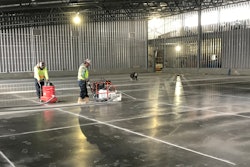
Recently, concrete has enjoyed a moment in the sun – generating long-form treatment in newspapers and magazine articles around the country. It’s understandable – the recent anniversary of the Inflation Reduction Act and the second anniversary of the Infrastructure Investment and Jobs Act are certain to drive conversation about a substance that most Americans are only now beginning to understand ranks as the second most used substance on earth behind only water.
Yet, despite the big headlines and interest in the industry ranging from Silicon Valley to Bill Gates, allow me to introduce a note of patience and caution even as we launch into the decarbonized era. First, it’s important to understand that while often used interchangeably, cement and concrete are two different things. Cement is actually an ingredient of concrete; concrete is a paste made up of aggregates and cement and concrete is one item therein. Given this mix of products, the industry has a crucial role to play in the effort to fight climate change, and doing so provides us with an opportunity to merge technology and craftsmanship in a way we’ve never had before.
Yet there are several factors the industry needs to consider before joining the breathless pronouncements about our industry and its capabilities. As a craftsman who has built his career at a company with more than 100 years in the business, there are three primary factors we would all do well to consider in days to come:
- Understanding that performance in the real world, not a lab, is still the most important measure of success;
- Ensuring that we maintain the ability to recommend the best materials regardless of political or social pressure; and
- That we retain the essential product ecosystem to develop and utilize our products.
The Intersection Of Science & Practicality
My career as a craftsman has always been spent at the intersection of science and practicality. After all, our general contractor partners and their clients don’t want to hear about how AI and the introduction of new materials are making concrete better – they want to know that it has the properties required to deliver to project specifications. It’s thrilling to see so many companies, both old names and new entrants, investing and creating new ideas – and I genuinely hope they continue.
However, in the rush to innovate and rush ahead with climate-driven solutions, the industry should also ensure that these products can do the job, not just today but over the multi-decade project scope that standard portland cement mixes have proven. Successfully doing this will require some big steps from the industry.
First, we should clearly define what “low carbon cement” means. Currently, no widespread industry standard exists, leading to both confusion among customers and a moving target for smaller operations that may not have the financial wherewithal to retrofit their equipment multiple times.
Second, we should develop a road map for decarbonized products that not only considers the creation of cementitious mixes in a lab but lays out a stringent set of industry standards to ensure our industry’s reputation stays as solid as the projects we develop.
Moreover, amidst the craze around low-carbon products, it will be equally crucial for our industry to avoid being backed into a corner. Certainly, incentives like the $6 billion for low carbon cement in the Inflation Reduction Act, as well as the interest of deep-pocketed private equity and environmental funds are motivational, but we should avoid a scenario where only the largest members of our industry can thrive, thanks to their ability to pivot operations to meet the latest environmental regulation or sustainability-driven whim.
My own company, Ozinga, has been in business for five generations near Chicago; as any small business owner can attest, survival for that amount of time takes equal parts fortitude, aptitude, and sometimes just plain luck. Forcing the host of smaller operators in our industry to adapt due to regulator fiat instead of free market development would be a betrayal of not just them but the generations of craftsmen that came before us. We should work hard to ensure that our customers and clients retain the choice of how to invest their dollars – and that our industry can capably fulfill their order – based on performance, engineering, and project specifications – not politics.
Insight Into Energy Goals
Finally, as our industry continues to gain public awareness, we would be wise to provide more insight into the delicate ecosystem that is developing due to energy transition. For example, the Federal Highway System has already cited fly ash, a byproduct of coal combustion, as an ingredient that “increases the strength and durability of hardened concrete”. Fly ash has become a hot topic for many power companies, particularly as public and political pressure over emissions increases. Currently, the public has little understanding of the concrete industry and even less awareness of the crucial role we could play as a link between carbon-intensive industries such as utilities, mining, manufacturing, and larger energy transition goals.
In addition to low-carbon solutions, the industry should take a vocal and proactive approach in helping guide the generational opportunity presented by the federal infrastructure bill and Inflation Reduction Act. Doing so will not only ensure a seat at the table amidst the next generation of infrastructure construction while also protecting the balance of fossil fuels, renewable energy, and low-carbon construction, which is a point of emphasis across all sectors.
There’s never been a better time to work in our industry, and I’m excited about the possibilities that await us as craftsmen in the years ahead. However, we also face some critical challenges – helping the general public gain a greater understanding of what we do, maintaining their trust by ensuring that low-carbon concrete works in the real world as well as it does in the lab, maintaining our independence and ability to prescribe the right product for each job and protecting the market ecosystem that helps our industry contribute to this economic transition are all big tasks.
Yet, this industry understands better than most how to build things that will stand the test of time – and I’m confident we’ll do the same in years to come.


















